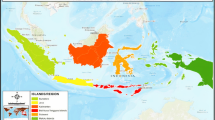Abstract.
The Sundarban, covering about one million ha in the delta of the rivers Ganga, Brahmaputra and Meghna is shared between Bangladesh (~60%) and India (~40%), and is the world’s largest coastal wetland. The area experiences a subtropical monsoonal climate with an annual rainfall of 1,600–1,800 mm and severe cyclonic storms. Enormous amounts of sediments carried by the rivers contribute to its expansion and dynamics. Salinity gradients change over a wide range of spatial and temporal scales. The biodiversity includes about 350 species of vascular plants, 250 fishes and 300 birds, besides numerous species of phytoplankton, fungi, bacteria, zooplankton, benthic invertebrates, molluscs, reptiles, amphibians and mammals. Species composition and community structure vary east to west, and along the hydrological and salinity gradients. Sundarban is the habitat of many rare and endangered animals (Batagur baska, Pelochelys bibroni, Chelonia mydas), especially the Royal Bengal tiger (Panthera tigris). Javan rhino, wild buffalo, hog deer, and barking deer are now extinct from the area. Large areas of the Sundarban mangroves have been converted into paddy fields over the past two centuries, and more recently into shrimp farms. The Sundarban has been extensively exploited for timber, fish, prawns and fodder. The regulation of river flows by a series of dams, barrages and embankments for diverting water upstream for various human needs and for flood control has caused large reduction in freshwater inflow and seriously affected the biodiversity because of an increase in salinity and changes in sedimentation. Heritiera fomes (locally called Sundari, from which Sundarban derives its name), Nypa fruticans and Phoenix paludosa are declining rapidly. During the past three decades, large parts of the remaining Sundarban have been protected for wildlife, particularly tiger, through the creation of several sanctuaries and a biosphere reserve. Parts of the Sundarban in both India and Bangladesh have been declared World Heritage sites. However, its biodiversity continues to be threatened by a growing human population that not only places pressure on its biological resources, but also impacts on the freshwater inflows from upstream areas. Oil exploration in coastal areas is also emerging as a new threat. Further threats arise from global climate change, especially sea level rise. The future of the Sundarban will depend upon the management of freshwater resources as much as on the conservation of its biological resources.
Similar content being viewed by others
Author information
Authors and Affiliations
Corresponding author
Additional information
Received: 15 December 2005; revised manuscript accepted: 9 March 2006
Rights and permissions
About this article
Cite this article
Gopal, B., Chauhan, M. Biodiversity and its conservation in the Sundarban Mangrove Ecosystem. Aquat. Sci. 68, 338–354 (2006). https://doi.org/10.1007/s00027-006-0868-8
Published:
Issue Date:
DOI: https://doi.org/10.1007/s00027-006-0868-8




